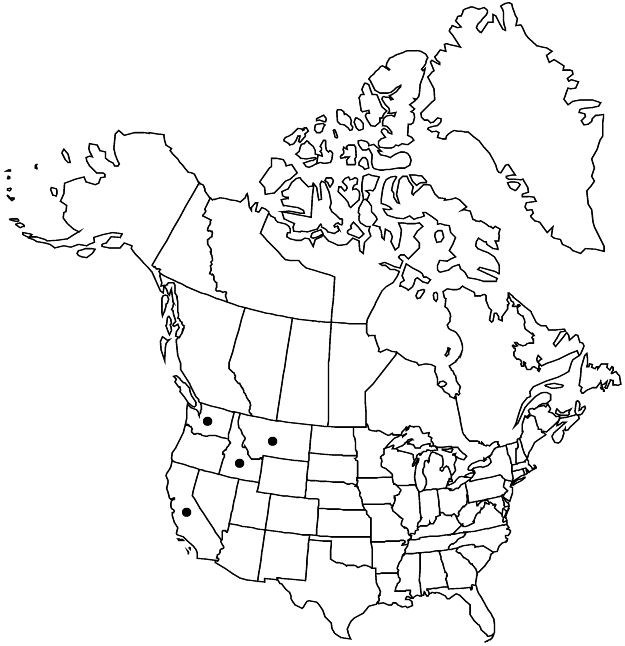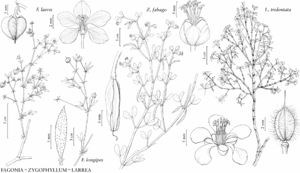Difference between revisions of "Zygophyllum fabago"
Sp. Pl. 1: 385. 1753.
FNA>Volume Importer |
FNA>Volume Importer |
||
| Line 34: | Line 34: | ||
|elevation=0–1000 m. | |elevation=0–1000 m. | ||
|distribution=Calif.;Idaho;Mont.;Wash.;s Europe;w;c Asia;n Africa. | |distribution=Calif.;Idaho;Mont.;Wash.;s Europe;w;c Asia;n Africa. | ||
| − | |discussion=<p>Zygophyllum fabago has been declared a noxious weed by California, Idaho, Nevada, Oregon, and Washington. Native to the Old World, it has been reported as a waif in Colorado, Kansas, Nevada (Churchill County), New Mexico, New York, Pennsylvania (Philadelphia), and Texas (El Paso County). In the flora area, the species has been referred to as Z. fabago var. brachycarpum Boissier, an invalid name.</p><!-- | + | |discussion=<p><i>Zygophyllum fabago</i> has been declared a noxious weed by California, Idaho, <i>Nevada</i>, Oregon, and Washington. Native to the Old World, it has been reported as a waif in Colorado, Kansas, <i>Nevada</i> (Churchill County), New Mexico, New York, Pennsylvania (Philadelphia), and Texas (El Paso County). In the flora area, the species has been referred to as <i>Z. fabago</i> var. brachycarpum Boissier, an invalid name.</p><!-- |
| − | --><p>In Spain, Zygophyllum fabago has been found to grow in coarse mineral soils contaminated with heavy metals and to accumulate cadmium (I. Lefèvre et al. 2005). Thus, it may potentially cause heavy metal poisoning in grazing stock, as well as alkaloid poisoning.</p> | + | --><p>In Spain, <i>Zygophyllum fabago</i> has been found to grow in coarse mineral soils contaminated with heavy metals and to accumulate cadmium (I. Lefèvre et al. 2005). Thus, it may potentially cause heavy metal poisoning in grazing stock, as well as alkaloid poisoning.</p> |
|tables= | |tables= | ||
|references= | |references= | ||
| Line 60: | Line 60: | ||
|publication year=1753 | |publication year=1753 | ||
|special status=Weedy;Introduced;Selected by author to be illustrated | |special status=Weedy;Introduced;Selected by author to be illustrated | ||
| − | |source xml=https://jpend@bitbucket.org/aafc-mbb/fna-data-curation.git/src/ | + | |source xml=https://jpend@bitbucket.org/aafc-mbb/fna-data-curation.git/src/8f726806613d60c220dc4493de13607dd3150896/coarse_grained_fna_xml/V12/V12_747.xml |
|genus=Zygophyllum | |genus=Zygophyllum | ||
|species=Zygophyllum fabago | |species=Zygophyllum fabago | ||
Revision as of 14:49, 18 September 2019
Herbs or subshrubs. Stems: branches ± spreading. Leaves 2–6 cm; proximal stipules basally connate, distal distinct, green, lanceolate to ovate or elliptic, 4–10 mm; petiole 1–1.5 cm; leaflets 1–4.5 × 0.6–3 cm; awn between leaflets linear or lanceolate, 1 mm. Pedicels 4–10 mm. Flowers 6–7 mm diam.; sepals ovate to elliptic, 5–7 × 3.5–5.5 mm, margins white; petals obovate, 7–8 mm; stamens exserted [included], 11–12 mm; filaments red-orange, ± linear, basal scales red-orange, apex notched; anthers red-orange. Capsules 1–3.5 × 0.4–0.5 cm; style threadlike, to 7 mm. Seeds 2–3 mm.
Phenology: Flowering Apr–Jun.
Habitat: Dry disturbed areas.
Elevation: 0–1000 m.
Distribution

Calif., Idaho, Mont., Wash., s Europe, w, c Asia, n Africa.
Discussion
Zygophyllum fabago has been declared a noxious weed by California, Idaho, Nevada, Oregon, and Washington. Native to the Old World, it has been reported as a waif in Colorado, Kansas, Nevada (Churchill County), New Mexico, New York, Pennsylvania (Philadelphia), and Texas (El Paso County). In the flora area, the species has been referred to as Z. fabago var. brachycarpum Boissier, an invalid name.
In Spain, Zygophyllum fabago has been found to grow in coarse mineral soils contaminated with heavy metals and to accumulate cadmium (I. Lefèvre et al. 2005). Thus, it may potentially cause heavy metal poisoning in grazing stock, as well as alkaloid poisoning.
Selected References
None.
